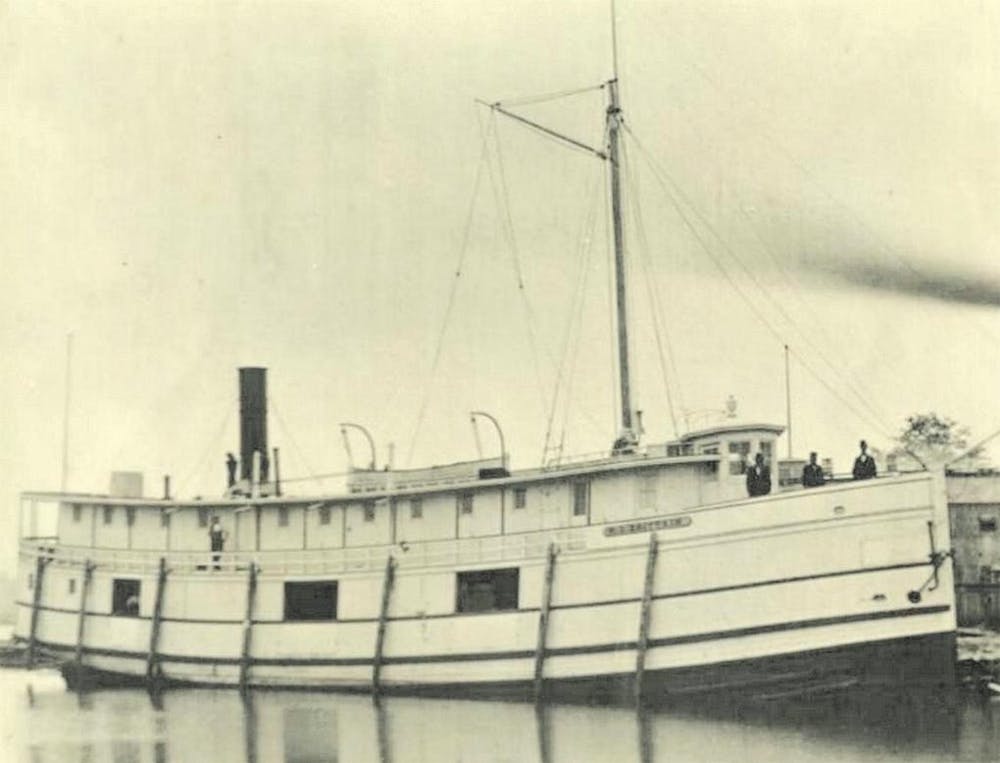In March 1880 the vessel R. C. Brittain was sold to Messers Staples & Covell which included A. J. Covell, C. E. Covell, M. B. Covell and Capt. Peter D. Campbell as owners. Together they formed the White Lake Transportation Co. This is just one of several other vessels that the company owned while they were in business.
The R. C. Brittain was built by James L. Elliott in Saginaw in 1877 for the passenger and fruit trade. The original owner was Ralph C. Brittain of that city.
It had a wooden hull which was 105’ in length, 22’ wide and 8’ in depth. It had one mast and a No 50 – 20” x 22” HPNC engine built by Henry Bloecker of Grand Haven. Classified as a propeller it carried both freight and passengers; 50 passenger berths were available.
In May 1881 the vessel was rebuilt and lengthened to 142.2’. It carried cargo, passengers, lumber and salt between Chicago – Muskegon – Whitehall.
In April 1883 extensive repairs were made to the boiler and other machinery.
On 10 December 1885 it was reported that the Brittain had a close call. The steamer left Chicago on Wednesday night about half-past four, headed for home, with about 8,000 bushels of grain. A fair southwest wind was blowing at the time, but about two hours later the wind began to veer to the northwest increasing until around midnight when it was blowing a regular gale.
Captain Campbell had to alter his course to keep the steamer clear of the deep troughs of the sea. He expected, however, to be able to make the harbor at Grand Haven, but the ship laid in the troughs and began rolling so heavily that the rigging parted and her mast and sail went overboard. Campbell again changed her course to make the harbor at Holland. When near this harbor the boat shot ahead and careened wildly under a big sea. The captain, seeing he was going to miss the harbor, stopped the engine and began backing. This threw the boat around to the south and she drifted down the shore about half a mile when the captain got her headed to sea and steaming out into the lake, turned and took another start for the harbor. This time he was successful but struck the south pier with such force as to break the boat’s rail amidships.
A pilot was secured from the lighthouse to take the boat to Holland City, but being an inexperienced man, he succeeded in running the boat into a sand bar in the harbor, from which it was removed by a tug and lighter.
Wild rumors went around the lake that the Brittain had foundered. Some of the rumors were caused by the boat’s pail rack, full of pails, being rolled overboard and drifting down to Saugatuck where the pails, bearing the Brittain’s name, were picked up. The carelessness of the pilot in Holland also lead to the rumor that the boat had gone ashore.
Captain Campbell said his crew all stood by him, not one of them showing any signs of fear or weakness but faced the dangers cheerfully and hopefully. The boat received about $300 worth of damage, but the cargo was kept safe and dry. Captain Campbell was proud of the way in which the Brittain carried herself, the storm being one of the most serious ones she had ever weathered and her action throughout the whole ordeal being most satisfactory.
On 27 January 1887 it was announced that the owners of the steamer Brittain let a contract for the building of a new propeller for the lake trade between Chicago and Whitehall. This move had been contemplated for some time as the old steamer was no longer adequate for the company’s increasing business. After 8 years of service, the vessel continued to run until the new propeller was completed. It was then sold to George Morley of Detroit in July 1887, who planned to use her in the lumber trade on Lake Huron.
The R. C. Brittain was replaced by the A. D Hayward.













